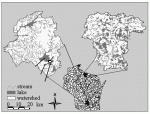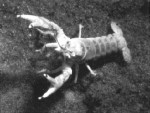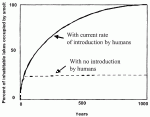Edited by John Magnuson and Tim Kratz
The NTL-LTER - An Overview
A lake has been studied traditionally as an entity, the microcosm of Stephen Forbes, or as a dynamic ecosystem interacting with its drainage basin. Scientific and practical questions have been directed more to the status of a lake than to its dynamics, and to a lake, rather than to suites of lakes in the landscape. The long temporal and the broad spatial scales inherent in the view of LTER research allow development of new insights that enrich our knowledge of status and dynamics of multiple-lake ecosystems.
With an LTER site, we now can ask questions such as "How can we predict how lakes will change over time and which lakes will change in the same way?" or "How can we determine whether the changes are unique to a given lake or part of a regional response?" Our ability to address such questions is favored by the island nature of lakes and the ease with which they can be viewed as ecosystems.
Our sites consist of seven lakes in a forested catchment of the Northern Highland Lake District in Northern Wisconsin and four lakes in agricultural and urban catchments of south-central Wisconsin. The LTER Program is operated by the Center for Limnology in the College of Letters and Science at the University of Wisconsin-Madison. The Center operates two field stations that enable the LTER Program and other aquatic research; these are the Trout Lake Station in the midst of the northern lakes and the Lake Mendota Laboratory in the midst of the southern lakes.
At NTL-LTER we examine the patterns, processes, and interactions of lakes and their surroundings at a nested set of spatial and temporal scales. In course of this study, we consider five spatial scales: individual lakes, multiple neighboring lakes, entire lake districts, the Upper Great Lakes region, and North Temperate Lakes globally. Temporally, we consider scales of within-year, among-years, decades, and centuries. We use multiple approaches, including long-term observations, comparative studies, experimental manipulations, and process modeling. Our research group includes ecologists, geologists, chemists, demographers, sociologists, climatologists, and remote sensing and data management specialists.
The North Temperate Lakes Long-Term Ecological Research program seeks to understand the long-term ecology of lakes and their interactions with a range of relevant landscape, atmospheric, and human processes. We find that many of the drivers of lake ecosystems come from these external forces such as changes in land use, dispersal of exotics, or the complex dynamics of regional and global climate. The internal dynamics of lake ecosystems are responsive to these external drivers. These studies have direct relevance to development of policies affecting the future status and dynamics of lake ecosystems in agricultural, forested, and urban landscapes.
In this article, we will discuss one aspect of these studies related to biodiversity: species invasions and extinctions, and the island nature of lakes. These dynamics and their regional implications rise from the nature of an LTER research platform. Our Principal Investigators are our key researchers in this project, as well as visiting scientists attracted to the LTER site, and especially the graduate students who pioneered the use of long-term data for their theses research. Much of the information in this article is taken from the thesis research of Tom Hrabik, Ann McLain, and Karen Wilson and studies by Tim Kratz, David Lodge, John Magnuson, and many others.
Published papers by these and other researchers that will help complete this story can be located through the North Temperate lakes LTER web page (http://limnosun.limnology.wisc.edu/).

 Enlarge this image
Enlarge this image


